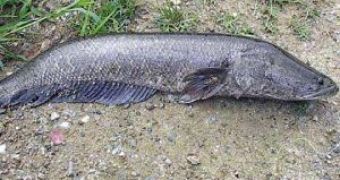Alien predatory fish species can greatly damage new ecosystems eliminating native species by competition or direct predation.
The northern snakehead fish (Channa argus) has already put a firm grip is in the U.S. This fish is native to North Eastern China, Korea and Amur River (Russia). It can grow up to 40 inch (1m) and 15 pounds (7kg). And it is a vicious eater of fishes, frogs, rats, crayfishes and other invertebrates. By now, to the relief of scientists and anglers, this species seems to coexist with native species without harming them.
The Potomac River, which runs through West Virginia, Virginia, Maryland, and Washington, D.C., has a healthy population of snakeheads after several of the fish were dumped into Dogue Creek, Fairfax County, Virginia. "We have not seen any adverse effects," said fisheries biologist Steve Owens, with Virginia's Department of Game and Inland Fisheries in Fredericksburg.
In Potomac River, this predatory species is appearing in more locations and in far greater densities than it previously did, occupying at least 15 miles (24 kilometers) of the Potomac River and its tributaries. The fish frequents weedy shallows (making eradication efforts almost impossible) and can breathe air, this making them able to resist till four days on land. "In places where they've had an introduction and they've established a beachhead, like snakeheads in the Potomac, we don't have any track record for being able to eradicate aquatic species like that," said Steve Minkkinen coordinates the U.S. Fish and Wildlife Service's snakehead control and management plan from Annapolis, Maryland.
Scientists feared that snakeheads - which can "walk" on land - could spread from one body of water to the next, covering large distances on land. But it seems that the particular species (Channa argus) cannot travel overland. "They are either going to swim to where they are going to get to, or, unfortunately, people can end up putting them in other places. That's the only way they could have gotten into the Potomac," Minkkinen said.
Anglers fear Potomac bass (also a non-native predatory species) could suffer from direct conflict with snakeheads, but recent reports show no noticeable decrease in bass numbers. Wildlife managers are still alerted to prevent the spread of the fish to other water courses. Much of the snakehead behavior and biology remains greatly unknown, so the Potomac population could serve as a live laboratory for research. Scientists will be watching over the next several weeks to see if there's a repetition of last October's mass migration of snakeheads, which could be crucial for explaining the snakehead's spreading. "I think we'd better use [the Potomac] as a place to learn what [the snakeheads'] impacts are going to be and learn about their general biology and behavior," Minkkinen said.
"Once we understand what their impacts are on the Potomac, we'll better understand what their impacts might be in other parts of the United States," he continued.
"Unfortunately they've been released in a huge watershed with thousands of acres of what looks like perfect habitat. I don't think we've begun to understand how well they are going to do."
"It will really be decades before we know the full impact."
There is a ban on trading live specimens of snekeheads in the U.S. since 2002, but the demand is big in North American Chinese markets as snakeheads are a delicacy in Asian cuisines. This seems to be the origin of the fishes that gave birth to the population from Potomac River. And it may not be a singular act in the U.S. The invasive fish may have first shown up in Virginia as early as 1998 or as late as 2002. In South Florida, another species of snakehead seems to have taken a hold at the same time. This population appears to be growing and its impact is still unknown. "The first bullseye snakehead showed up in a suburb of Fort Lauderdale in the year 2000," said Walter Courtenay Jr., a biologist and snakehead expert with the U.S. Geological Survey in Gainesville, Florida.
"They are in the canals and ponds-which spread all over Southeast Florida like a road map."
And Channa argus have already entered Pennsylvania. They were found in two ponds in South Philadelphia that drain into the Schuylkill River near its confluence with the Delaware River and were already fished in the Delaware. Snakeheads were also spotted in Illinois (Lake Michigan), New York City (Flushing Meadows Park), Washington, California, Texas, Alabama, North Carolina, Rhode Island, Maine, Massachusetts, Maryland.

 14 DAY TRIAL //
14 DAY TRIAL //